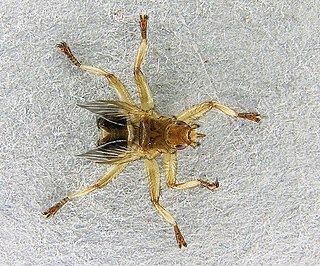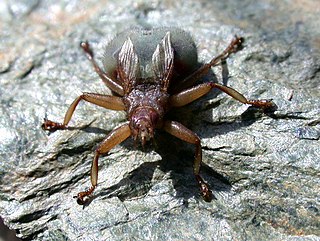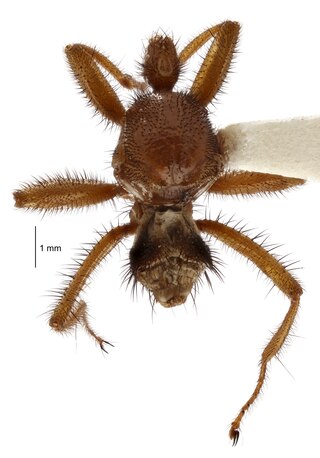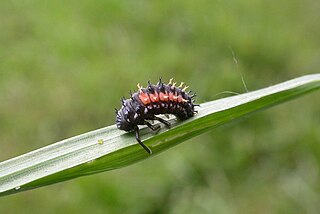Related Research Articles

Calyptratae is a subsection of Schizophora in the insect order Diptera, commonly referred to as the calyptrate muscoids. It consists of those flies which possess a calypter that covers the halteres, among which are some of the most familiar of all flies, such as the house fly.

Oestroidea is a superfamily of Calyptratae including the blow flies, bot flies, flesh flies, and their relatives. It occurs worldwide and has about 15,000 described species.

Hippoboscoidea is a superfamily of the Calyptratae. The flies in this superfamily are blood-feeding obligate parasites of their hosts. Four families are often placed here:
Holometabolism, also called complete metamorphosis, is a form of insect development which includes four life stages: egg, larva, pupa, and imago. Holometabolism is a synapomorphic trait of all insects in the superorder Holometabola. Immature stages of holometabolous insects are very different from the mature stage. In some species the holometabolous life cycle prevents larvae from competing with adults because they inhabit different ecological niches. The morphology and behavior of each stage are adapted for different activities. For example, larval traits maximize feeding, growth, and development, while adult traits enable dispersal, mating, and egg laying. Some species of holometabolous insects protect and feed their offspring. Other insect developmental strategies include ametabolism and hemimetabolism.
Adenotrophic viviparity means "gland fed, live birth". This is the reproductive mode of insects such as tsetse flies (Glossinidae), keds (Hippoboscidae) and bat flies, as adenotrophic viviparity is a characteristic feature of the superfamily Hippoboscoidea. It has also been observed in members of the subfamily Mesembrinellinae.

Hippoboscidae, the louse flies or keds, are obligate parasites of mammals and birds. In this family, the winged species can fly at least reasonably well, though others with vestigial or no wings are flightless and highly apomorphic. As usual in their superfamily Hippoboscoidea, most of the larval development takes place within the mother's body, and pupation occurs almost immediately.

The Streblidae are a family of flies in the superfamily Hippoboscoidea, and together with their relatives the Nycteribiidae, are known as bat flies. They are winged or wingless ectoparasites of bats, and often have long legs. They appear to be host-specific, with different species of bat flies occurring only on particular species of bat hosts, sometimes with multiple species of flies sharing a host bat.

Nycteribiidae is a family of the true fly superfamily Hippoboscoidea. Together with their close relatives the Streblidae, they are known as "bat flies". As the latter do not seem to be a monophyletic group, it is conceivable that bat flies cannot be united into a single family.

The Egyptian tomb bat is a species of sac-winged bat in the family Emballonuridae. It is a medium- to large-sized microbat with a mass of approximately 30 g (1.1 oz).

Crataerina is a genus of louse flies in the family Hippoboscidae. All are parasites of birds, feeding on the blood of various species of Apodidae (swifts) and Hirundinidae. The genus is sometimes spelled Craterina.

The New Zealand bat fly is a small, wingless insect which lives in a commensal relationship with the New Zealand lesser short-tailed bat. It is a true fly, in the order Diptera, placed in its own genus, Mystacinobia, and its own family, Mystacinobiidae. Although many other species of bat fly exist throughout the world, the New Zealand bat fly is endemic to the islands of New Zealand. Unlike other similar looking bat flies, this species is not a parasite and is only phoretic, feeding on bat guano. It appears to be the only insect, parasitic or otherwise, which lives with these bats.

Ornithomyinae is a subfamily of the fly family Hippoboscidae. All are blood feeding parasites, for the most part on birds, though some have mammals as hosts.
Gloeandromyces is a genus of fungi in the family Laboulbeniaceae. The genus contains five species. All species are associated with Neotropical bat flies.

Vetufebrus is an extinct genus of haemospororida in the family Plasmodiidae. At the time of its description the new genus comprised a single species Vetufebrus ovatus known from a single Miocene Dominican amber fossil found on Hispaniola. V. ovatus was vectored by Enischnomyia stegosoma, the first fossil streblid bat fly described from a fossil, and the only member of the subfamily Nycterophiliinae described from Hispaniola. V. ovatus is the first instance of a Streblidae bat fly as a host for a malarial parasite.

Nycteribia kolenatii is a species of fly in the family Nycteribiidae. It is found in the Palearctic.
Ulurumyia macalpinei is a species of fly in the superfamily Oestroidea endemic to Australia. It is the only species of genus Ulurumyia, which in turn is the only genus of family Ulurumyiidae, making the latter two taxa monotypic. It was first discovered in the 1970s, but was not described until 2017, and in the intervening decades was informally known to entomologists as McAlpine's fly. It breeds in dung and is said to be clearly distinct from other oestroid families but its exact position within the superfamily has not been determined with certainty. The genus name Ulurumyia is derived from the Australian monolith Uluru and from myia, the Greek word for fly; the species name macalpinei commemorates the Australian dipterist David K. McAlpine, the first person to collect specimens of this fly and realize their evolutionary distinctiveness.
Basilia fletcheri is parasitic bat fly in the genus Basilia, in the subgenus Basilia. It is found in India.

Enischnomyia is an extinct genus of bat fly in the family Streblidae. At the time of its description the new genus comprised a single species, Enischnomyia stegosoma, known from a single Miocene fossil found on Hispaniola. E. stegosoma was the first fossil streblid bat fly described from a fossil, and the only member of the subfamily Nycterophiliinae described from Hispaniola. The species is host for the plasmodiid Vetufebrus ovatus preserved in its salivary glands and midgut.

The prepupa is a stage in the life cycle of certain insects, following the larva or nymph and preceding the pupa. It occurs in both holometabolous and hemimetabolous insects.
References
- ↑ Bertola, Patrícia Beloto; Aires, Caroline Cotrim; Favorito, Sandra Elisa; Graciolli, Gustavo; Amaku, Marcos; Pinto-Da-Rocha, Ricardo (2005). "Bat flies (Diptera: Streblidae, Nycteribiidae) parasitic on bats (Mammalia: Chiroptera) at Parque Estadual da Cantareira, São Paulo, Brazil: Parasitism rates and host-parasite associations". Memórias do Instituto Oswaldo Cruz. 100 (1): 25–32. doi: 10.1590/S0074-02762005000100005 . PMID 15867959.
- ↑ Morse, Solon F.; Olival, Kevin J.; Kosoy, Michael; Billeter, Sarah; Patterson, Bruce D.; Dick, Carl W.; Dittmar, Katharina (2012). "Global distribution and genetic diversity of Bartonella in bat flies (Hippoboscoidea, Streblidae, Nycteribiidae)". Infection, Genetics and Evolution. 12 (8): 1717–1723. doi:10.1016/j.meegid.2012.06.009. PMID 22771358.
- ↑ Dick, Carl W. (2016). "Streblidae (Bat Flies)". Encyclopedia of Parasitology. pp. 2561–2564. doi:10.1007/978-3-662-43978-4_3463. ISBN 978-3-662-43977-7.
- ↑ Gleeson, D. M.; Howitt, R. L. J.; Newcomb, R. D. (2000). "The phylogenetic position of the New Zealand batfly, Mystacinobia zelandica (Mystacinobiidae; Oestroidea) inferred from mitochondrial 16S ribosomal DNA sequence data". Journal of the Royal Society of New Zealand. 30 (2): 155–168. doi:10.1080/03014223.2000.9517615. ISSN 0303-6758.